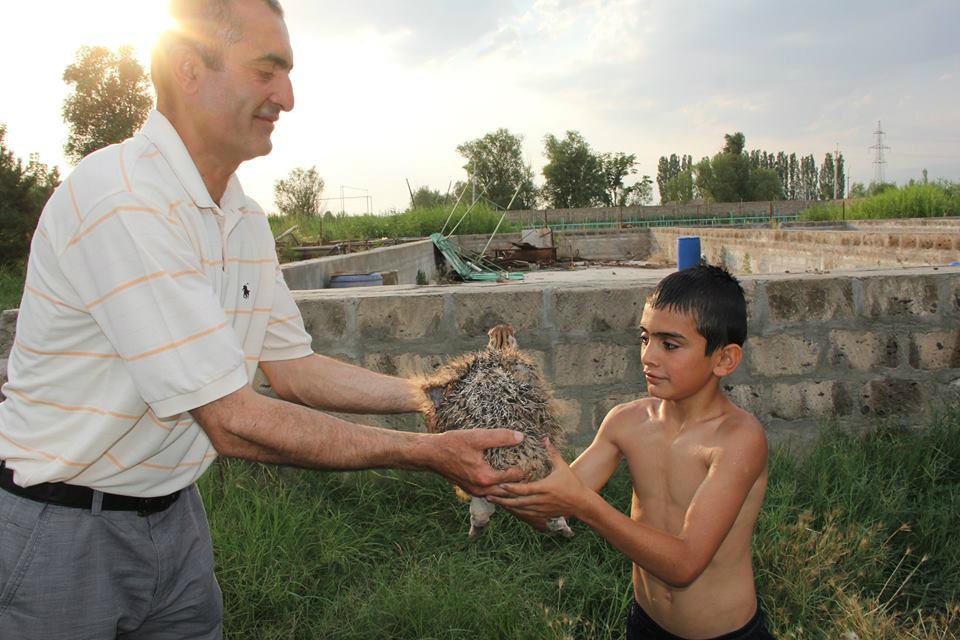A unique ostriches farm in Armenia is at risk
Tigran’s ostriches know how to behave when seeing the man who feeds them. They used to greet their master by dancing, whereas now they silently come up to him, as if sharing his anxiety.


Business startup
Dandalosh [translated as Dawdler], Gonch [Heavy-headed], Kuyr [Blind] and Petravor [Feathery] came to Armenia from Iran. Gonch, the largest and most impressive of them, is aggressive and unsociable.
Tigran Khachatryan, a native of Jrarat, brought these ostriches to Armenia 7 years ago. First he studied the theory of ostrich farming and discovered that this business was quite profitable.
But before making his final decision, Tigran, a doctor by profession, learned all the nuances of ostrich breeding and familiarized himself with international best practices. He underwent advanced training courses abroad and only after that did he bring the ostriches to Armenia and built an incubator.

Only 19 out of 24 ostriches safely reached Armenia. Five birds did not survive the journey. According to Tigran, it’s a rather good indicator of how the transportation fared.
He says the ostriches are easy to keep, they are cost-effective and they are resistant to diseases.

These animals, which weigh 120-160 kg, need 2-3 kg of feed and 4-5 minutes of care daily. The ostriches spend winter outdoors, and don’t need either special lighting or heating. They eat wheat, corn and chopped herbs.
Initial success
Tigran had a clear-cut business plan, whereby he, on the one hand, would expand his business and, on the other hand, would be provided with a steady income. It was necessary to construct buildings and facilities to procure the necessary equipment and create a location for the feed. He had to finance all these things himself.

Tigran introduced his plans to banks, which received the idea of ostrich farming with incredulity. The only way out was to hypothecate real estate and pawn jewelry.
The ostriches adapted to the Armenian climate, ensuring the desired projected growth and in 3-4 years became sexually mature, which meant that the expenditure phase was over, and it was time to make some profit.
Tigran was going to sell the ostrich chicks that hatched in the incubator. They were in high demand in Armenia at that time. His business was improving from year to year: 70 ostrich chicks were born in 2013, 220 in 2014 and 330 in 2015.

The business would have prospered if the ostriches had continued to receive a sufficient amount of food and the proper quality of food, which is essential for their reproduction. Eggs of malnourished ostriches cannot guarantee procreation of offspring. It was for that reason that in 2016, only 10 out of the 200 eggs hatched into chicks on Tigran’s farm over the course of 6 months.
Why the ostriches are malnourished
Tigran’s business plan foresaw almost all the risks and the ways to overcome them. However, what he could not foresee was that some oligarch would decide to bring 3,000 ostrich chicks to the town of Kapan from Iran, and, having no relevant professionals to develop his business, he would not only destroy his own farming economy within three years, but would also do harm to that particular branch as a whole.
Ostrich meat, eggs and chicks depreciated in value. In Tigran’s words, ‘low quality’ birds were imported and, in order to avoid significant losses, the owners started selling meat and eggs at very low prices.
According to Tigran, 600 tons of ostrich meat went to the market all at the same time, and it exceeded demand several times. A kilo of meat dropped almost three times in value.
A drop in the purchasing capacity over the past two years, coupled with the aforementioned factors, have brought Tigran’s business to a stalemate.

On the one hand, he has had to pay high interests for credits and, on the other, to maintain at least 36 pairs of males and females, which are capable of reproducing. The meager income he made must somehow cover the overdue interest in banks. As a result, not only the adult ostriches, but also the newborns, can’t survive because of malnutrition. Tigran’s business has incurred heavy losses.
Double-trouble
The malnourished ostrich chicks are unable to survive on their own and Tigran has to keep them, from the very first days of their life, in a specially designed chamber. And even in this case he cannot always save them. Two incubators are almost empty this year.

It turned out that not all of the ostrich eggs hatch into chicks. Tigran has recently had to withdraw three boxes of unfit eggs from the incubator. To save his business, he has had to reduce ostrich feed to a critical minimum. The malnourished birds often can’t even stand on their feet. It is hard for Tigran to observe the decline of his farming business which he had been creating for years.

According to him, ostriches are one of those rare species that can bring in a really big profit because you can use not only their meat and eggs, but also their feathers, skin and nails. It must also be noted that ostrich eggshells are used for making various jewelry items and accessories. The only problem is that it’s not customary to process and use ‘raw materials’ from ostriches in Armenia.

Tigran says ostrich skin is not inferior to that of a crocodile or snakeskin, but people are not accustomed to using it. In order to export the meat or the skin, he needs special permission which he is unable to obtain. He says the raw materials could have been exported to Russia, but the Russian Federation imposed a ban on the import of unprocessed meat.

How to save the ostriches
According to Tigran’s estimates, if the creditor banks freeze his loans for a year, he will be able to use the proceeds in order to purchase high-quality feed. Consequently, the ostriches, receiving normal nutrition, will have no problems with reproduction.

In his words, the demand for chicks has increased on the market, and the annual income will allow his business to revive and him to pay off his loans.

A one-month old ostrich chick costs AMD 35,000-40,000 (about USD 70-85), the price for one ostrich egg amounts to AMD 5,000 (a little bit more than USD 10), and a one-year old, well-fed ostrich can yield up to 50-60 kg of meat. At the moment, Tigran’s one-year old ostriches weigh less than 20 kg.
Published: 13.07.2016



















